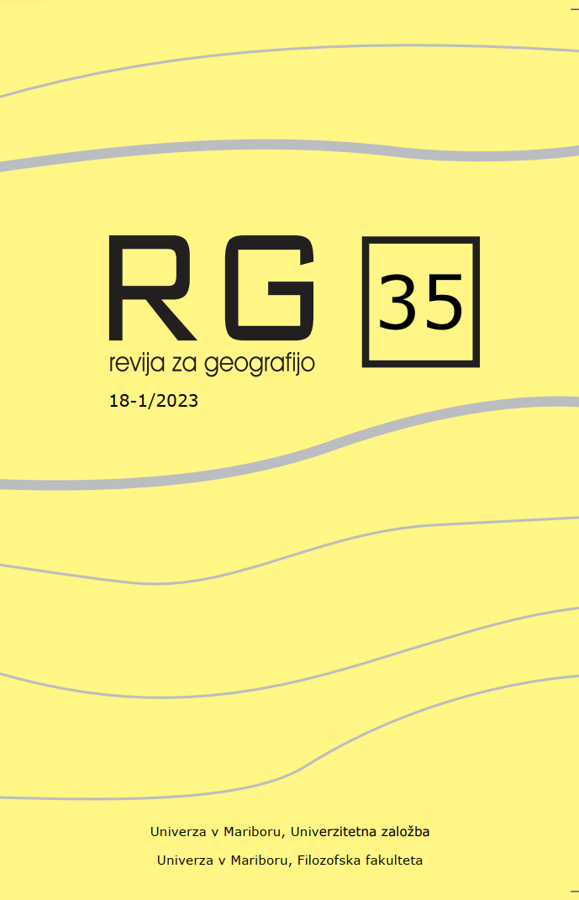Influence of Political and Socioeconomic Factors on Population Distribution in Bosnia and Herzegovina
DOI:
https://doi.org/10.18690/rg.18.1.3245Keywords:
Bosnia and Herzegovina, influential factors, political factors, socioeconomic status, population distributionAbstract
The findings suggest that the political situation in Bosnia and Herzegovina significantly impacts population distribution across the entire territory. It can be concluded that the deterioration of specific socioeconomic conditions (e.g., employment, living standards) in the country is reflected in the overall demographic trends. The paper provides an overview of the political processes before and after the conflict in Bosnia and Herzegovina, which have led to an imbalanced and potentially problematic distribution of population throughout the territory. Additionally, it discusses the detailed socioeconomic conditions in past decades, which have contributed to continuous migration from Bosnia and Herzegovina to European Union countries. Demographic analyses drew upon the results of the last two censuses conducted in 1991 and 2013, documenting the latest distribution of population and density changes.
Downloads
References
Ahmetbegović, S. (2015). Klima kao faktor razmještaja stanovništva i naselja u Bosni I Hercegovini, Acta geographica, Bosniae et Herzegovinae 3,17-29.
BiH Statistics Agency [BHAS]. (2013). Retrieved from https:// www.popis.gov.ba/popis2013/
BiH Statistics Agency [BHAS]. (2022). Women and Men in Bosnia and Herzegovina. Retrieved from https://bhas.gov.ba/data/Publikacije/ Bilteni/ 2022/FAM_00_2021_TB_1_BS.pdf
Cvitković, I. (Ed.). (2017). Demografske i etničke promjene u BiH: Zbornik radova. Akademija nauka i umjetnosti Bosne i Hercegovine.
Družić, S. (2020). Demografsko starenje stanovništva i socijalna politika, Zbornik radova Islamskog pedagoškog fakulteta u Bihaću, 12(12), 265-287.
Emirhafizović, M. (2018): Kad demografska zima zakuca na vrata, Denatalitet i prirodna depopulacija u Bosni i Hercegovini Journal of Interdisciplinary Studies,5(1), 7-24.
Ethno-map of Bosnia and Herzegovina. (2013, October 2). Retrieved from https://bosnjaci.wordpress.com/2013/10/02/etno-karta-bh-stanovnistva-po-opstinama-1992-i-danas/
Korjenić, A., & Nezirović, S. (2022). Zaštita okoliša i plansko upravljanje. Univerzitetski udžbenik.
Ministry of Security of Bosnia and Herzegovina [MSB]. (2023). Migration profile BiH for the year 2022.
Nezirović, S. (2022). Regionalna geografija Bosne i Hercegovine II. Univerzitetski udžbenik.
Nezirović, S. Drešković N. & Mirić, R. (2018). Concept of tourist and economic regionalization of Bosnia and Herzegovina with special reference on the Tuzla tourist-geographical region in the area of northern Bosnia. Revija za geografijo 13(2),19-38.
Nezirović , S. & Sivac, A. (2018): Savremeni problem regionalnog razvoja u svijetu. Univerzitetski udžbenik.
Pejanović, M. (2018). Promjena etničke strukture općina u Bosni i Hercegovini prema popisu stanovništva 2013. godine, Časopis za ekonomiju i politiku tranzicije, 20(42).
Puljiz, V. (2015). Starenje stanovništva – izazov socijalne politike. Revija za socijalnu politiku, 23(1), 81-98.
United Nations Population Fund Bosnia and Herzegovina [UNFPA]. (2020). Population Situation Analysis in Bosnia and Herzegovina
Downloads
Published
Issue
Section
License
Copyright (c) 2023 Senada Nezirović

This work is licensed under a Creative Commons Attribution 4.0 International License.
